Financial Management Report: Accounting and Decision Making
VerifiedAdded on 2020/11/12
|13
|3995
|194
Report
AI Summary
This report delves into the core aspects of financial management, examining both formal and informal approaches to effective decision-making within organizations. It explores key financial principles, such as consistency, accountability, and transparency, which are crucial for formulating successful financial strategies. The report also evaluates the role and responsibilities of management accountants, highlighting their significance in maintaining financial records, optimizing capital structure, and supporting internal decision-making processes. Furthermore, it analyzes the value of accounting control systems as integral components of integrated business systems, ensuring the reliability and validity of financial positions. The report also includes a discussion on the importance of financial decision-making in supporting long-term financial stability, including ratio analysis. The report concludes with an overview of how companies can set objectives to attain financial aims, such as ethical constraints and increasing shareholder wealth.

Financial management
Paraphrase This Document
Need a fresh take? Get an instant paraphrase of this document with our AI Paraphraser
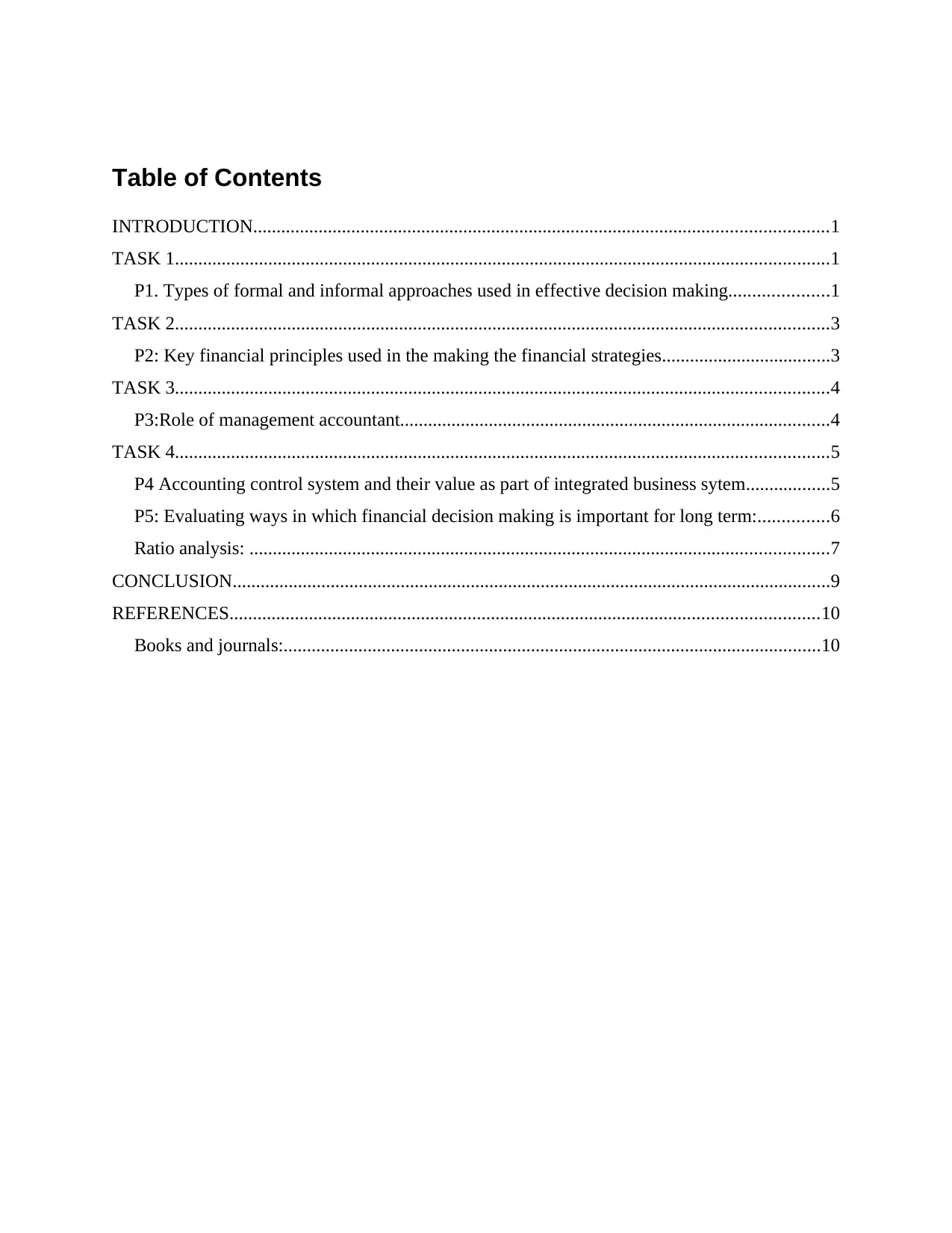
Table of Contents
INTRODUCTION...........................................................................................................................1
TASK 1............................................................................................................................................1
P1. Types of formal and informal approaches used in effective decision making.....................1
TASK 2............................................................................................................................................3
P2: Key financial principles used in the making the financial strategies....................................3
TASK 3............................................................................................................................................4
P3:Role of management accountant............................................................................................4
TASK 4............................................................................................................................................5
P4 Accounting control system and their value as part of integrated business sytem..................5
P5: Evaluating ways in which financial decision making is important for long term:...............6
Ratio analysis: ............................................................................................................................7
CONCLUSION................................................................................................................................9
REFERENCES..............................................................................................................................10
Books and journals:...................................................................................................................10
INTRODUCTION...........................................................................................................................1
TASK 1............................................................................................................................................1
P1. Types of formal and informal approaches used in effective decision making.....................1
TASK 2............................................................................................................................................3
P2: Key financial principles used in the making the financial strategies....................................3
TASK 3............................................................................................................................................4
P3:Role of management accountant............................................................................................4
TASK 4............................................................................................................................................5
P4 Accounting control system and their value as part of integrated business sytem..................5
P5: Evaluating ways in which financial decision making is important for long term:...............6
Ratio analysis: ............................................................................................................................7
CONCLUSION................................................................................................................................9
REFERENCES..............................................................................................................................10
Books and journals:...................................................................................................................10
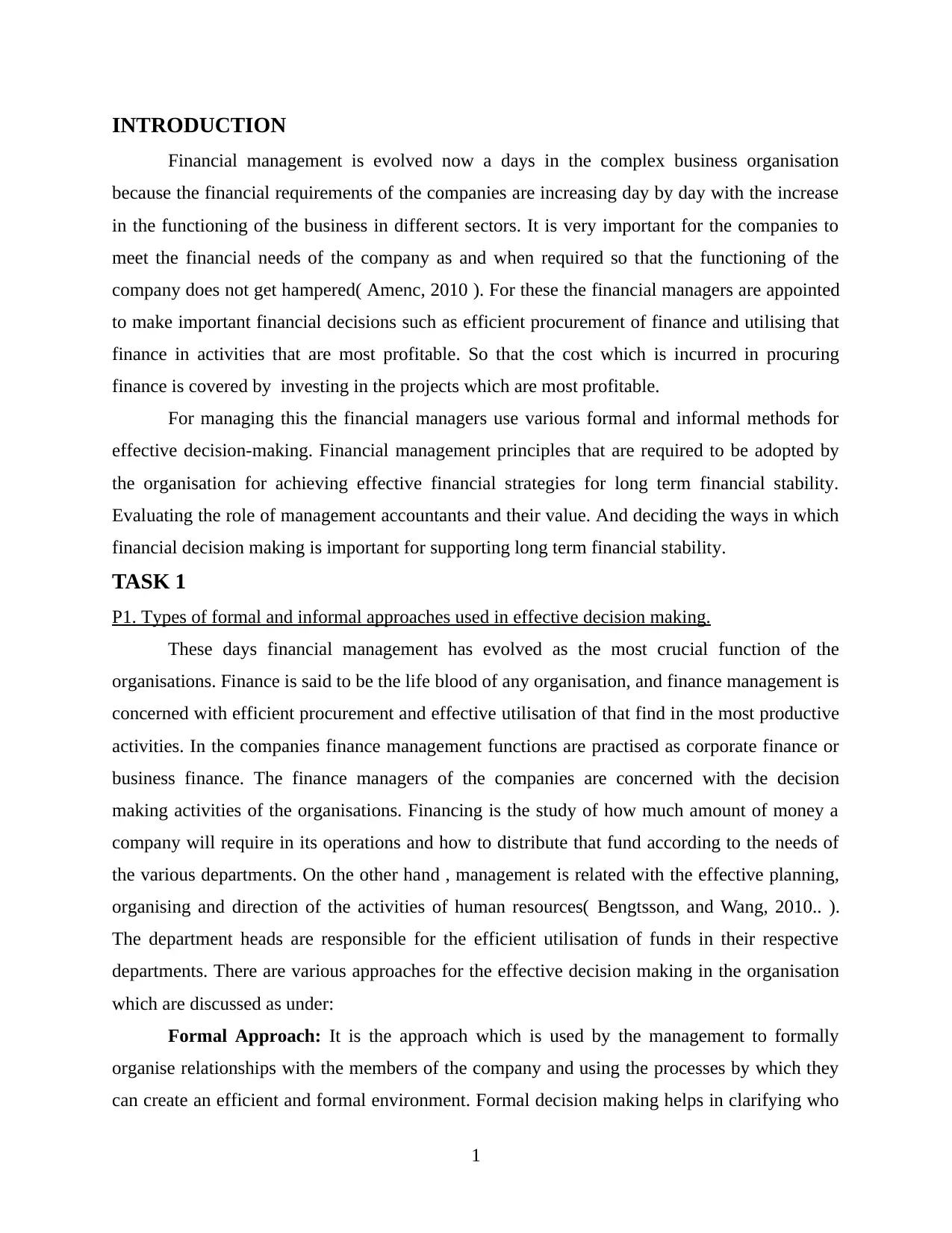
INTRODUCTION
Financial management is evolved now a days in the complex business organisation
because the financial requirements of the companies are increasing day by day with the increase
in the functioning of the business in different sectors. It is very important for the companies to
meet the financial needs of the company as and when required so that the functioning of the
company does not get hampered( Amenc, 2010 ). For these the financial managers are appointed
to make important financial decisions such as efficient procurement of finance and utilising that
finance in activities that are most profitable. So that the cost which is incurred in procuring
finance is covered by investing in the projects which are most profitable.
For managing this the financial managers use various formal and informal methods for
effective decision-making. Financial management principles that are required to be adopted by
the organisation for achieving effective financial strategies for long term financial stability.
Evaluating the role of management accountants and their value. And deciding the ways in which
financial decision making is important for supporting long term financial stability.
TASK 1
P1. Types of formal and informal approaches used in effective decision making.
These days financial management has evolved as the most crucial function of the
organisations. Finance is said to be the life blood of any organisation, and finance management is
concerned with efficient procurement and effective utilisation of that find in the most productive
activities. In the companies finance management functions are practised as corporate finance or
business finance. The finance managers of the companies are concerned with the decision
making activities of the organisations. Financing is the study of how much amount of money a
company will require in its operations and how to distribute that fund according to the needs of
the various departments. On the other hand , management is related with the effective planning,
organising and direction of the activities of human resources( Bengtsson, and Wang, 2010.. ).
The department heads are responsible for the efficient utilisation of funds in their respective
departments. There are various approaches for the effective decision making in the organisation
which are discussed as under:
Formal Approach: It is the approach which is used by the management to formally
organise relationships with the members of the company and using the processes by which they
can create an efficient and formal environment. Formal decision making helps in clarifying who
1
Financial management is evolved now a days in the complex business organisation
because the financial requirements of the companies are increasing day by day with the increase
in the functioning of the business in different sectors. It is very important for the companies to
meet the financial needs of the company as and when required so that the functioning of the
company does not get hampered( Amenc, 2010 ). For these the financial managers are appointed
to make important financial decisions such as efficient procurement of finance and utilising that
finance in activities that are most profitable. So that the cost which is incurred in procuring
finance is covered by investing in the projects which are most profitable.
For managing this the financial managers use various formal and informal methods for
effective decision-making. Financial management principles that are required to be adopted by
the organisation for achieving effective financial strategies for long term financial stability.
Evaluating the role of management accountants and their value. And deciding the ways in which
financial decision making is important for supporting long term financial stability.
TASK 1
P1. Types of formal and informal approaches used in effective decision making.
These days financial management has evolved as the most crucial function of the
organisations. Finance is said to be the life blood of any organisation, and finance management is
concerned with efficient procurement and effective utilisation of that find in the most productive
activities. In the companies finance management functions are practised as corporate finance or
business finance. The finance managers of the companies are concerned with the decision
making activities of the organisations. Financing is the study of how much amount of money a
company will require in its operations and how to distribute that fund according to the needs of
the various departments. On the other hand , management is related with the effective planning,
organising and direction of the activities of human resources( Bengtsson, and Wang, 2010.. ).
The department heads are responsible for the efficient utilisation of funds in their respective
departments. There are various approaches for the effective decision making in the organisation
which are discussed as under:
Formal Approach: It is the approach which is used by the management to formally
organise relationships with the members of the company and using the processes by which they
can create an efficient and formal environment. Formal decision making helps in clarifying who
1
⊘ This is a preview!⊘
Do you want full access?
Subscribe today to unlock all pages.

Trusted by 1+ million students worldwide
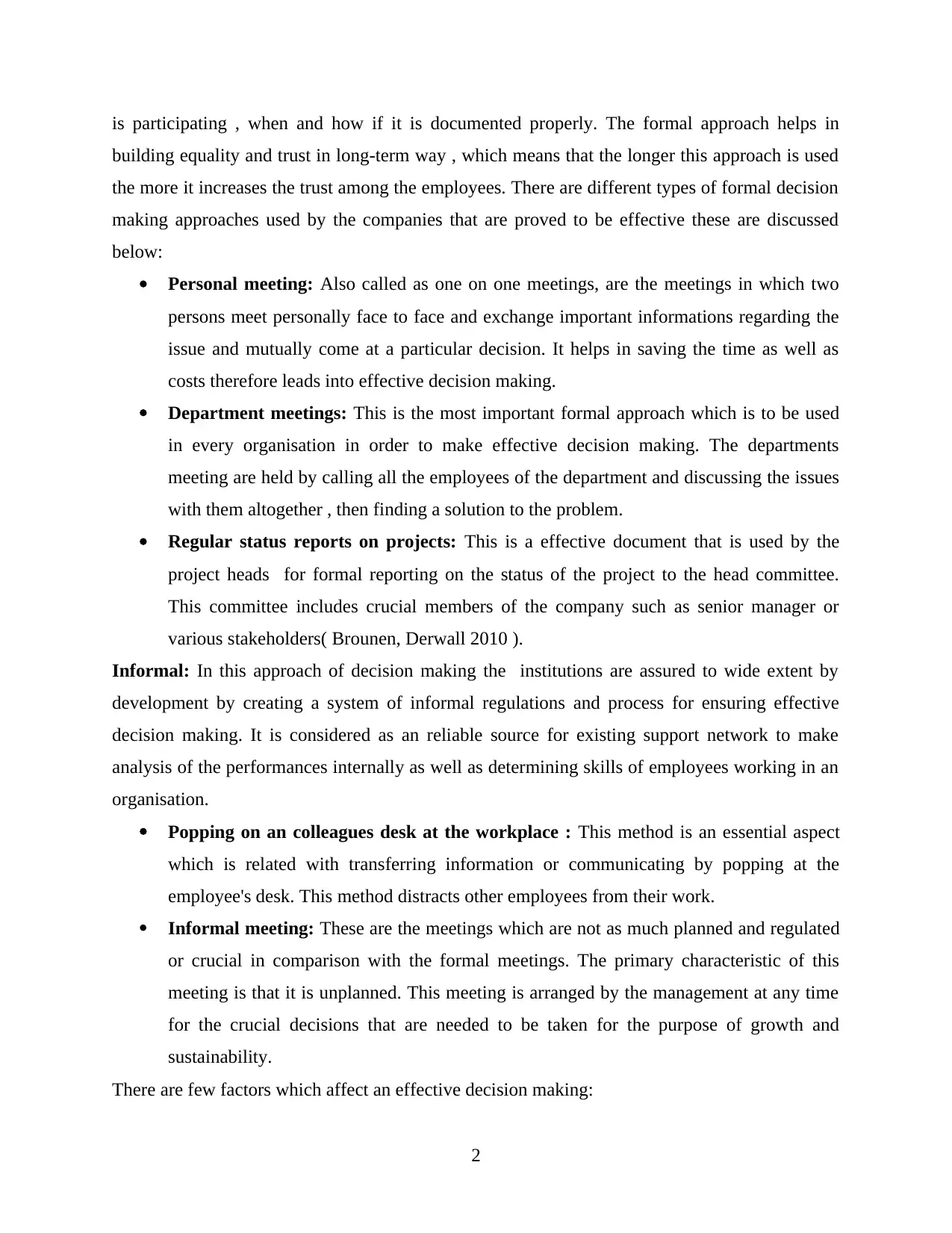
is participating , when and how if it is documented properly. The formal approach helps in
building equality and trust in long-term way , which means that the longer this approach is used
the more it increases the trust among the employees. There are different types of formal decision
making approaches used by the companies that are proved to be effective these are discussed
below:
Personal meeting: Also called as one on one meetings, are the meetings in which two
persons meet personally face to face and exchange important informations regarding the
issue and mutually come at a particular decision. It helps in saving the time as well as
costs therefore leads into effective decision making.
Department meetings: This is the most important formal approach which is to be used
in every organisation in order to make effective decision making. The departments
meeting are held by calling all the employees of the department and discussing the issues
with them altogether , then finding a solution to the problem.
Regular status reports on projects: This is a effective document that is used by the
project heads for formal reporting on the status of the project to the head committee.
This committee includes crucial members of the company such as senior manager or
various stakeholders( Brounen, Derwall 2010 ).
Informal: In this approach of decision making the institutions are assured to wide extent by
development by creating a system of informal regulations and process for ensuring effective
decision making. It is considered as an reliable source for existing support network to make
analysis of the performances internally as well as determining skills of employees working in an
organisation.
Popping on an colleagues desk at the workplace : This method is an essential aspect
which is related with transferring information or communicating by popping at the
employee's desk. This method distracts other employees from their work.
Informal meeting: These are the meetings which are not as much planned and regulated
or crucial in comparison with the formal meetings. The primary characteristic of this
meeting is that it is unplanned. This meeting is arranged by the management at any time
for the crucial decisions that are needed to be taken for the purpose of growth and
sustainability.
There are few factors which affect an effective decision making:
2
building equality and trust in long-term way , which means that the longer this approach is used
the more it increases the trust among the employees. There are different types of formal decision
making approaches used by the companies that are proved to be effective these are discussed
below:
Personal meeting: Also called as one on one meetings, are the meetings in which two
persons meet personally face to face and exchange important informations regarding the
issue and mutually come at a particular decision. It helps in saving the time as well as
costs therefore leads into effective decision making.
Department meetings: This is the most important formal approach which is to be used
in every organisation in order to make effective decision making. The departments
meeting are held by calling all the employees of the department and discussing the issues
with them altogether , then finding a solution to the problem.
Regular status reports on projects: This is a effective document that is used by the
project heads for formal reporting on the status of the project to the head committee.
This committee includes crucial members of the company such as senior manager or
various stakeholders( Brounen, Derwall 2010 ).
Informal: In this approach of decision making the institutions are assured to wide extent by
development by creating a system of informal regulations and process for ensuring effective
decision making. It is considered as an reliable source for existing support network to make
analysis of the performances internally as well as determining skills of employees working in an
organisation.
Popping on an colleagues desk at the workplace : This method is an essential aspect
which is related with transferring information or communicating by popping at the
employee's desk. This method distracts other employees from their work.
Informal meeting: These are the meetings which are not as much planned and regulated
or crucial in comparison with the formal meetings. The primary characteristic of this
meeting is that it is unplanned. This meeting is arranged by the management at any time
for the crucial decisions that are needed to be taken for the purpose of growth and
sustainability.
There are few factors which affect an effective decision making:
2
Paraphrase This Document
Need a fresh take? Get an instant paraphrase of this document with our AI Paraphraser
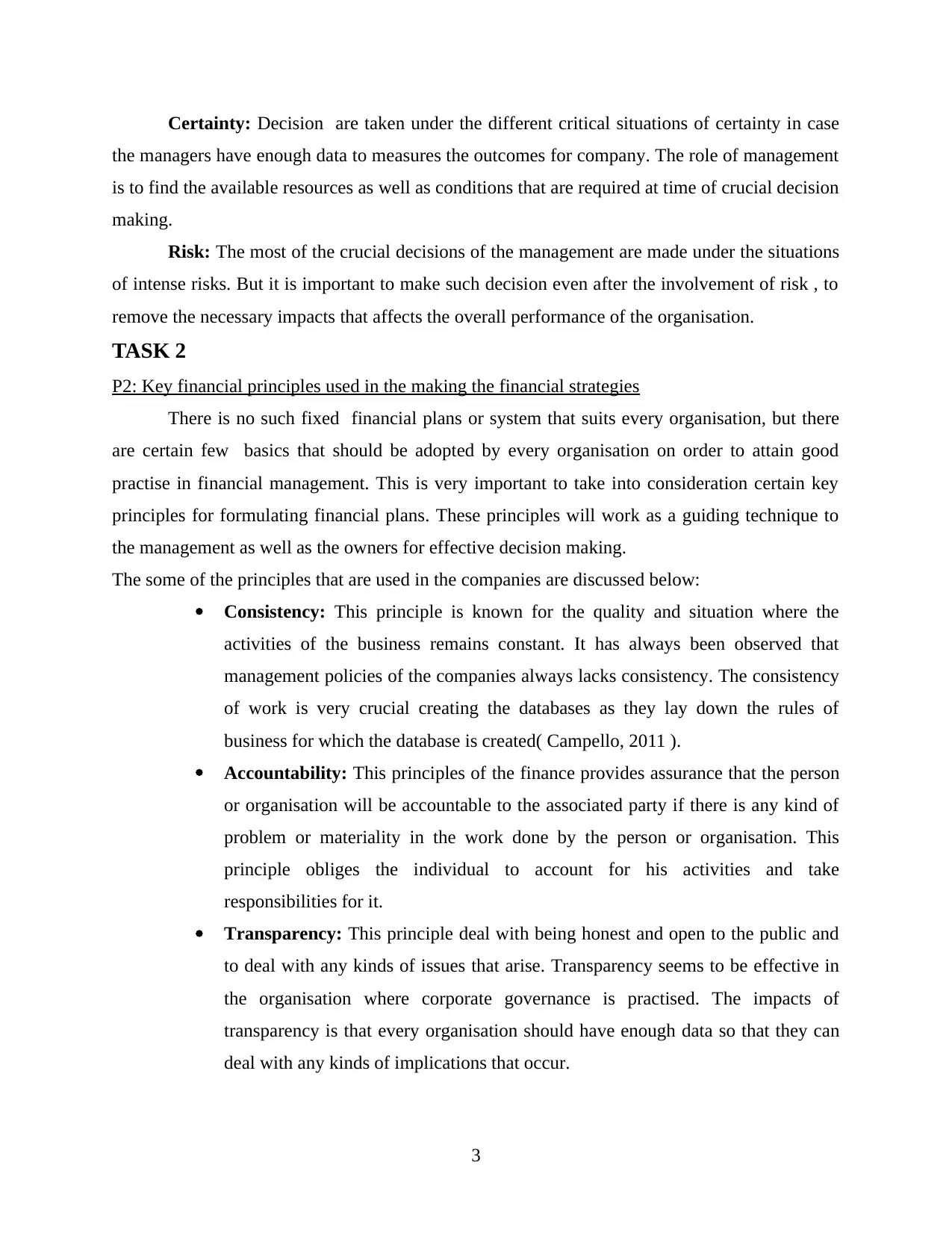
Certainty: Decision are taken under the different critical situations of certainty in case
the managers have enough data to measures the outcomes for company. The role of management
is to find the available resources as well as conditions that are required at time of crucial decision
making.
Risk: The most of the crucial decisions of the management are made under the situations
of intense risks. But it is important to make such decision even after the involvement of risk , to
remove the necessary impacts that affects the overall performance of the organisation.
TASK 2
P2: Key financial principles used in the making the financial strategies
There is no such fixed financial plans or system that suits every organisation, but there
are certain few basics that should be adopted by every organisation on order to attain good
practise in financial management. This is very important to take into consideration certain key
principles for formulating financial plans. These principles will work as a guiding technique to
the management as well as the owners for effective decision making.
The some of the principles that are used in the companies are discussed below:
Consistency: This principle is known for the quality and situation where the
activities of the business remains constant. It has always been observed that
management policies of the companies always lacks consistency. The consistency
of work is very crucial creating the databases as they lay down the rules of
business for which the database is created( Campello, 2011 ).
Accountability: This principles of the finance provides assurance that the person
or organisation will be accountable to the associated party if there is any kind of
problem or materiality in the work done by the person or organisation. This
principle obliges the individual to account for his activities and take
responsibilities for it.
Transparency: This principle deal with being honest and open to the public and
to deal with any kinds of issues that arise. Transparency seems to be effective in
the organisation where corporate governance is practised. The impacts of
transparency is that every organisation should have enough data so that they can
deal with any kinds of implications that occur.
3
the managers have enough data to measures the outcomes for company. The role of management
is to find the available resources as well as conditions that are required at time of crucial decision
making.
Risk: The most of the crucial decisions of the management are made under the situations
of intense risks. But it is important to make such decision even after the involvement of risk , to
remove the necessary impacts that affects the overall performance of the organisation.
TASK 2
P2: Key financial principles used in the making the financial strategies
There is no such fixed financial plans or system that suits every organisation, but there
are certain few basics that should be adopted by every organisation on order to attain good
practise in financial management. This is very important to take into consideration certain key
principles for formulating financial plans. These principles will work as a guiding technique to
the management as well as the owners for effective decision making.
The some of the principles that are used in the companies are discussed below:
Consistency: This principle is known for the quality and situation where the
activities of the business remains constant. It has always been observed that
management policies of the companies always lacks consistency. The consistency
of work is very crucial creating the databases as they lay down the rules of
business for which the database is created( Campello, 2011 ).
Accountability: This principles of the finance provides assurance that the person
or organisation will be accountable to the associated party if there is any kind of
problem or materiality in the work done by the person or organisation. This
principle obliges the individual to account for his activities and take
responsibilities for it.
Transparency: This principle deal with being honest and open to the public and
to deal with any kinds of issues that arise. Transparency seems to be effective in
the organisation where corporate governance is practised. The impacts of
transparency is that every organisation should have enough data so that they can
deal with any kinds of implications that occur.
3
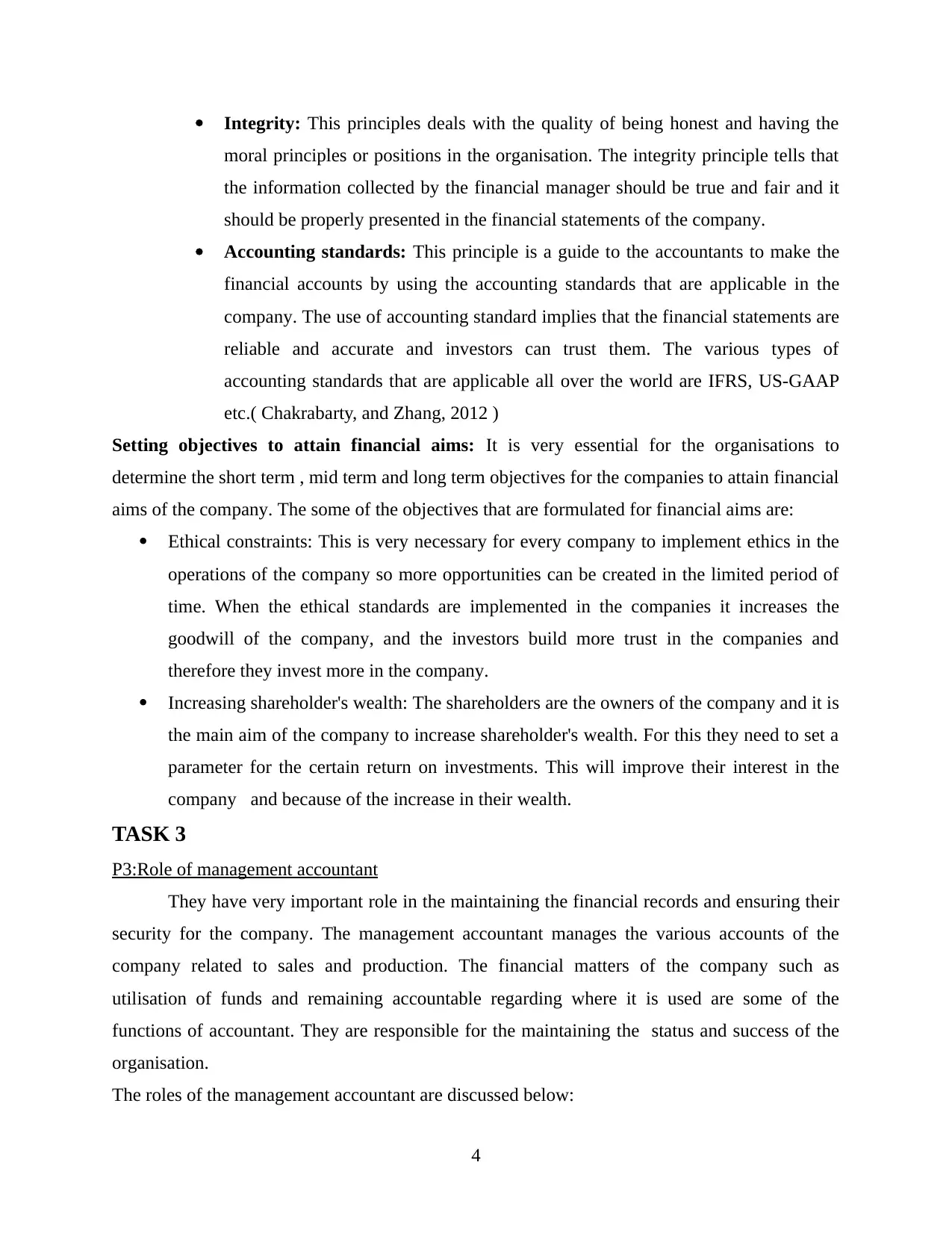
Integrity: This principles deals with the quality of being honest and having the
moral principles or positions in the organisation. The integrity principle tells that
the information collected by the financial manager should be true and fair and it
should be properly presented in the financial statements of the company.
Accounting standards: This principle is a guide to the accountants to make the
financial accounts by using the accounting standards that are applicable in the
company. The use of accounting standard implies that the financial statements are
reliable and accurate and investors can trust them. The various types of
accounting standards that are applicable all over the world are IFRS, US-GAAP
etc.( Chakrabarty, and Zhang, 2012 )
Setting objectives to attain financial aims: It is very essential for the organisations to
determine the short term , mid term and long term objectives for the companies to attain financial
aims of the company. The some of the objectives that are formulated for financial aims are:
Ethical constraints: This is very necessary for every company to implement ethics in the
operations of the company so more opportunities can be created in the limited period of
time. When the ethical standards are implemented in the companies it increases the
goodwill of the company, and the investors build more trust in the companies and
therefore they invest more in the company.
Increasing shareholder's wealth: The shareholders are the owners of the company and it is
the main aim of the company to increase shareholder's wealth. For this they need to set a
parameter for the certain return on investments. This will improve their interest in the
company and because of the increase in their wealth.
TASK 3
P3:Role of management accountant
They have very important role in the maintaining the financial records and ensuring their
security for the company. The management accountant manages the various accounts of the
company related to sales and production. The financial matters of the company such as
utilisation of funds and remaining accountable regarding where it is used are some of the
functions of accountant. They are responsible for the maintaining the status and success of the
organisation.
The roles of the management accountant are discussed below:
4
moral principles or positions in the organisation. The integrity principle tells that
the information collected by the financial manager should be true and fair and it
should be properly presented in the financial statements of the company.
Accounting standards: This principle is a guide to the accountants to make the
financial accounts by using the accounting standards that are applicable in the
company. The use of accounting standard implies that the financial statements are
reliable and accurate and investors can trust them. The various types of
accounting standards that are applicable all over the world are IFRS, US-GAAP
etc.( Chakrabarty, and Zhang, 2012 )
Setting objectives to attain financial aims: It is very essential for the organisations to
determine the short term , mid term and long term objectives for the companies to attain financial
aims of the company. The some of the objectives that are formulated for financial aims are:
Ethical constraints: This is very necessary for every company to implement ethics in the
operations of the company so more opportunities can be created in the limited period of
time. When the ethical standards are implemented in the companies it increases the
goodwill of the company, and the investors build more trust in the companies and
therefore they invest more in the company.
Increasing shareholder's wealth: The shareholders are the owners of the company and it is
the main aim of the company to increase shareholder's wealth. For this they need to set a
parameter for the certain return on investments. This will improve their interest in the
company and because of the increase in their wealth.
TASK 3
P3:Role of management accountant
They have very important role in the maintaining the financial records and ensuring their
security for the company. The management accountant manages the various accounts of the
company related to sales and production. The financial matters of the company such as
utilisation of funds and remaining accountable regarding where it is used are some of the
functions of accountant. They are responsible for the maintaining the status and success of the
organisation.
The roles of the management accountant are discussed below:
4
⊘ This is a preview!⊘
Do you want full access?
Subscribe today to unlock all pages.

Trusted by 1+ million students worldwide
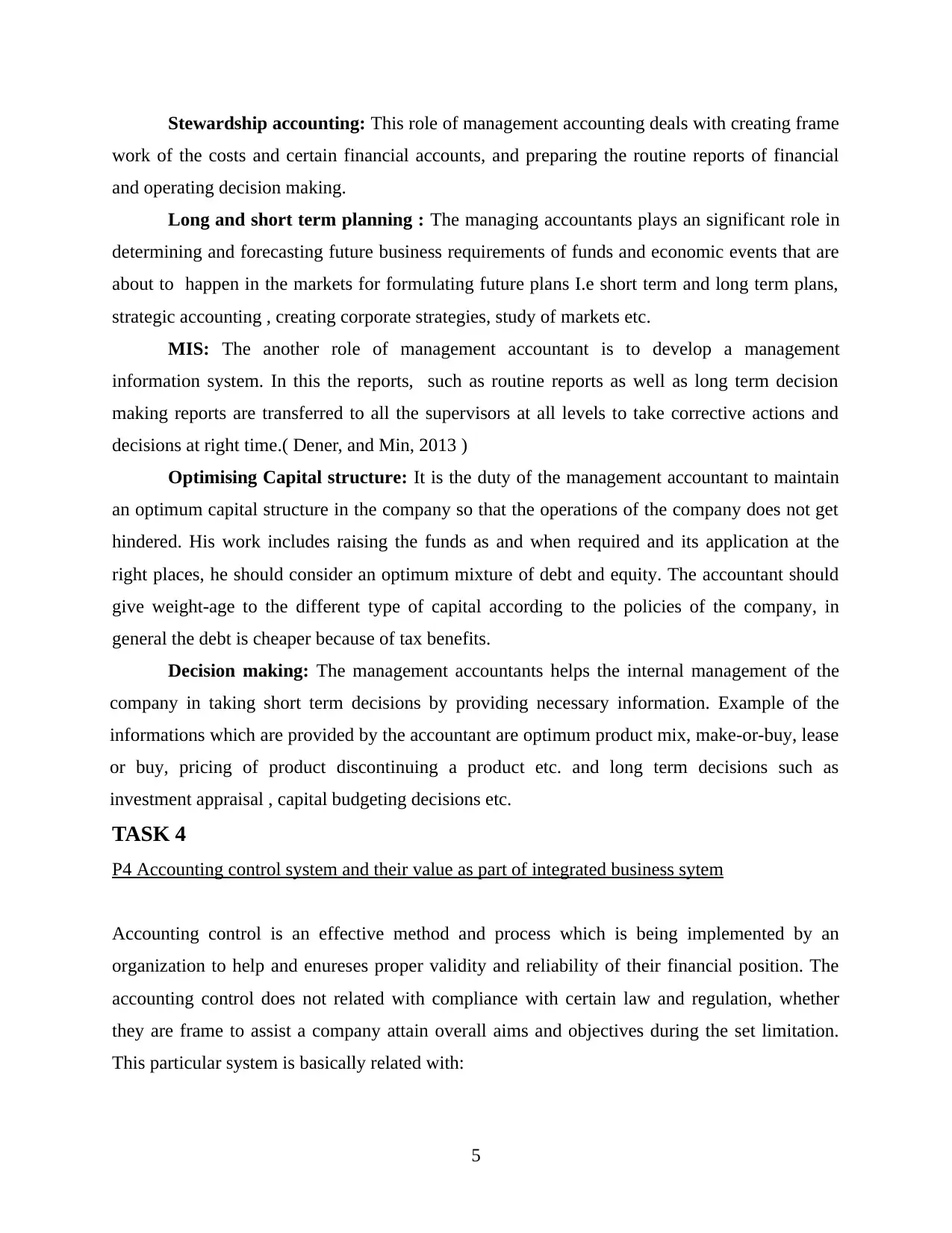
Stewardship accounting: This role of management accounting deals with creating frame
work of the costs and certain financial accounts, and preparing the routine reports of financial
and operating decision making.
Long and short term planning : The managing accountants plays an significant role in
determining and forecasting future business requirements of funds and economic events that are
about to happen in the markets for formulating future plans I.e short term and long term plans,
strategic accounting , creating corporate strategies, study of markets etc.
MIS: The another role of management accountant is to develop a management
information system. In this the reports, such as routine reports as well as long term decision
making reports are transferred to all the supervisors at all levels to take corrective actions and
decisions at right time.( Dener, and Min, 2013 )
Optimising Capital structure: It is the duty of the management accountant to maintain
an optimum capital structure in the company so that the operations of the company does not get
hindered. His work includes raising the funds as and when required and its application at the
right places, he should consider an optimum mixture of debt and equity. The accountant should
give weight-age to the different type of capital according to the policies of the company, in
general the debt is cheaper because of tax benefits.
Decision making: The management accountants helps the internal management of the
company in taking short term decisions by providing necessary information. Example of the
informations which are provided by the accountant are optimum product mix, make-or-buy, lease
or buy, pricing of product discontinuing a product etc. and long term decisions such as
investment appraisal , capital budgeting decisions etc.
TASK 4
P4 Accounting control system and their value as part of integrated business sytem
Accounting control is an effective method and process which is being implemented by an
organization to help and enureses proper validity and reliability of their financial position. The
accounting control does not related with compliance with certain law and regulation, whether
they are frame to assist a company attain overall aims and objectives during the set limitation.
This particular system is basically related with:
5
work of the costs and certain financial accounts, and preparing the routine reports of financial
and operating decision making.
Long and short term planning : The managing accountants plays an significant role in
determining and forecasting future business requirements of funds and economic events that are
about to happen in the markets for formulating future plans I.e short term and long term plans,
strategic accounting , creating corporate strategies, study of markets etc.
MIS: The another role of management accountant is to develop a management
information system. In this the reports, such as routine reports as well as long term decision
making reports are transferred to all the supervisors at all levels to take corrective actions and
decisions at right time.( Dener, and Min, 2013 )
Optimising Capital structure: It is the duty of the management accountant to maintain
an optimum capital structure in the company so that the operations of the company does not get
hindered. His work includes raising the funds as and when required and its application at the
right places, he should consider an optimum mixture of debt and equity. The accountant should
give weight-age to the different type of capital according to the policies of the company, in
general the debt is cheaper because of tax benefits.
Decision making: The management accountants helps the internal management of the
company in taking short term decisions by providing necessary information. Example of the
informations which are provided by the accountant are optimum product mix, make-or-buy, lease
or buy, pricing of product discontinuing a product etc. and long term decisions such as
investment appraisal , capital budgeting decisions etc.
TASK 4
P4 Accounting control system and their value as part of integrated business sytem
Accounting control is an effective method and process which is being implemented by an
organization to help and enureses proper validity and reliability of their financial position. The
accounting control does not related with compliance with certain law and regulation, whether
they are frame to assist a company attain overall aims and objectives during the set limitation.
This particular system is basically related with:
5
Paraphrase This Document
Need a fresh take? Get an instant paraphrase of this document with our AI Paraphraser
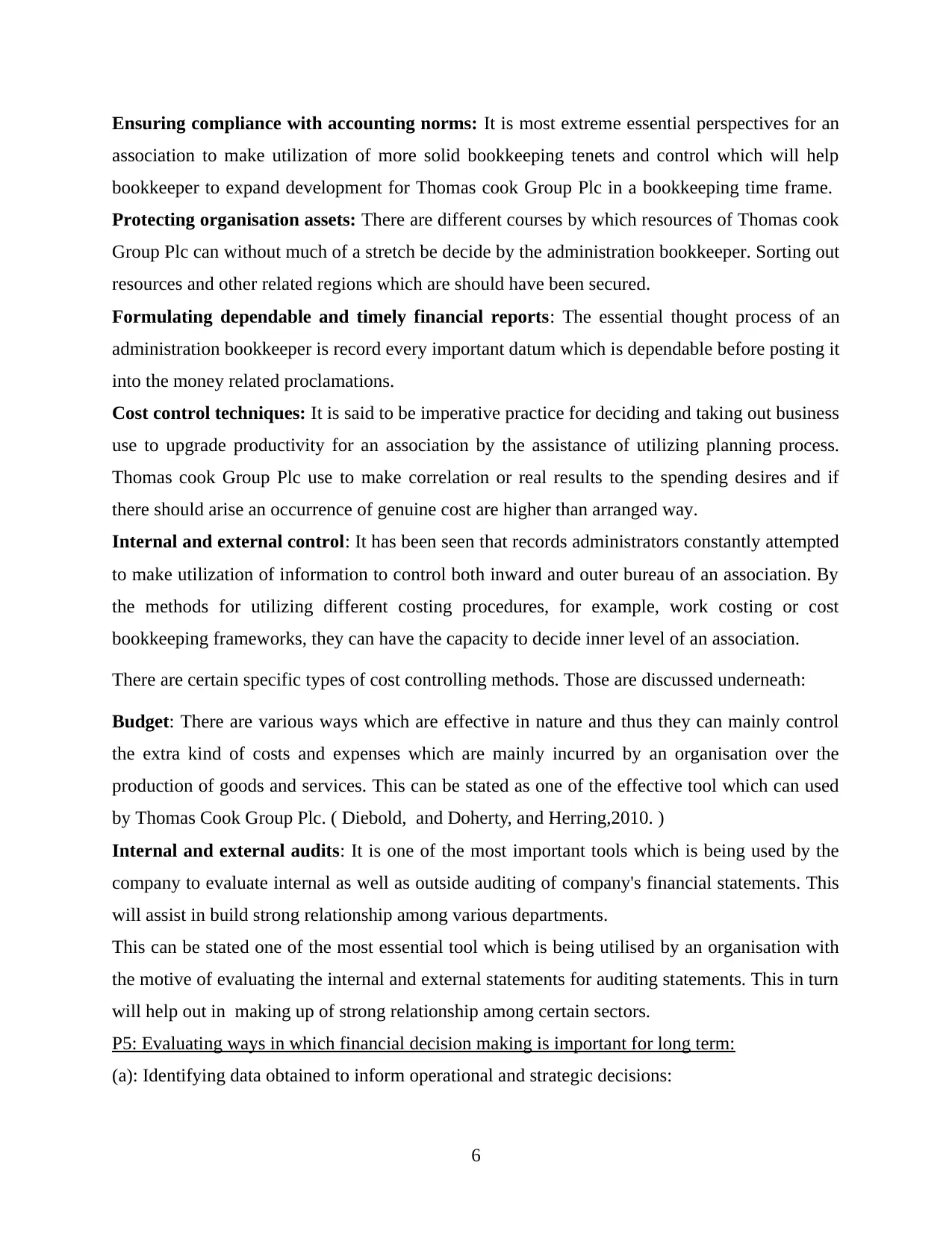
Ensuring compliance with accounting norms: It is most extreme essential perspectives for an
association to make utilization of more solid bookkeeping tenets and control which will help
bookkeeper to expand development for Thomas cook Group Plc in a bookkeeping time frame.
Protecting organisation assets: There are different courses by which resources of Thomas cook
Group Plc can without much of a stretch be decide by the administration bookkeeper. Sorting out
resources and other related regions which are should have been secured.
Formulating dependable and timely financial reports: The essential thought process of an
administration bookkeeper is record every important datum which is dependable before posting it
into the money related proclamations.
Cost control techniques: It is said to be imperative practice for deciding and taking out business
use to upgrade productivity for an association by the assistance of utilizing planning process.
Thomas cook Group Plc use to make correlation or real results to the spending desires and if
there should arise an occurrence of genuine cost are higher than arranged way.
Internal and external control: It has been seen that records administrators constantly attempted
to make utilization of information to control both inward and outer bureau of an association. By
the methods for utilizing different costing procedures, for example, work costing or cost
bookkeeping frameworks, they can have the capacity to decide inner level of an association.
There are certain specific types of cost controlling methods. Those are discussed underneath:
Budget: There are various ways which are effective in nature and thus they can mainly control
the extra kind of costs and expenses which are mainly incurred by an organisation over the
production of goods and services. This can be stated as one of the effective tool which can used
by Thomas Cook Group Plc. ( Diebold, and Doherty, and Herring,2010. )
Internal and external audits: It is one of the most important tools which is being used by the
company to evaluate internal as well as outside auditing of company's financial statements. This
will assist in build strong relationship among various departments.
This can be stated one of the most essential tool which is being utilised by an organisation with
the motive of evaluating the internal and external statements for auditing statements. This in turn
will help out in making up of strong relationship among certain sectors.
P5: Evaluating ways in which financial decision making is important for long term:
(a): Identifying data obtained to inform operational and strategic decisions:
6
association to make utilization of more solid bookkeeping tenets and control which will help
bookkeeper to expand development for Thomas cook Group Plc in a bookkeeping time frame.
Protecting organisation assets: There are different courses by which resources of Thomas cook
Group Plc can without much of a stretch be decide by the administration bookkeeper. Sorting out
resources and other related regions which are should have been secured.
Formulating dependable and timely financial reports: The essential thought process of an
administration bookkeeper is record every important datum which is dependable before posting it
into the money related proclamations.
Cost control techniques: It is said to be imperative practice for deciding and taking out business
use to upgrade productivity for an association by the assistance of utilizing planning process.
Thomas cook Group Plc use to make correlation or real results to the spending desires and if
there should arise an occurrence of genuine cost are higher than arranged way.
Internal and external control: It has been seen that records administrators constantly attempted
to make utilization of information to control both inward and outer bureau of an association. By
the methods for utilizing different costing procedures, for example, work costing or cost
bookkeeping frameworks, they can have the capacity to decide inner level of an association.
There are certain specific types of cost controlling methods. Those are discussed underneath:
Budget: There are various ways which are effective in nature and thus they can mainly control
the extra kind of costs and expenses which are mainly incurred by an organisation over the
production of goods and services. This can be stated as one of the effective tool which can used
by Thomas Cook Group Plc. ( Diebold, and Doherty, and Herring,2010. )
Internal and external audits: It is one of the most important tools which is being used by the
company to evaluate internal as well as outside auditing of company's financial statements. This
will assist in build strong relationship among various departments.
This can be stated one of the most essential tool which is being utilised by an organisation with
the motive of evaluating the internal and external statements for auditing statements. This in turn
will help out in making up of strong relationship among certain sectors.
P5: Evaluating ways in which financial decision making is important for long term:
(a): Identifying data obtained to inform operational and strategic decisions:
6
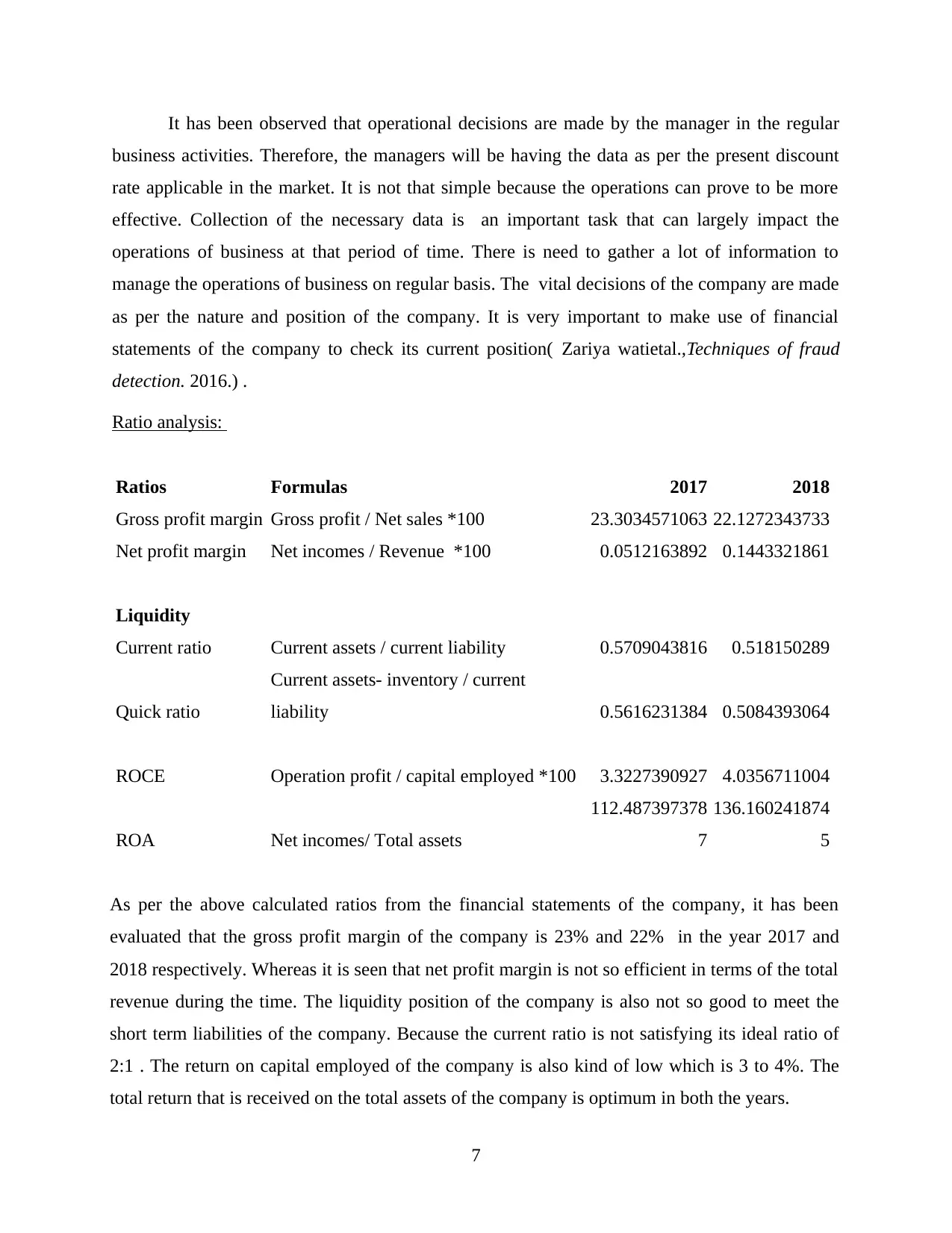
It has been observed that operational decisions are made by the manager in the regular
business activities. Therefore, the managers will be having the data as per the present discount
rate applicable in the market. It is not that simple because the operations can prove to be more
effective. Collection of the necessary data is an important task that can largely impact the
operations of business at that period of time. There is need to gather a lot of information to
manage the operations of business on regular basis. The vital decisions of the company are made
as per the nature and position of the company. It is very important to make use of financial
statements of the company to check its current position( Zariya watietal.,Techniques of fraud
detection. 2016.) .
Ratio analysis:
Ratios Formulas 2017 2018
Gross profit margin Gross profit / Net sales *100 23.3034571063 22.1272343733
Net profit margin Net incomes / Revenue *100 0.0512163892 0.1443321861
Liquidity
Current ratio Current assets / current liability 0.5709043816 0.518150289
Quick ratio
Current assets- inventory / current
liability 0.5616231384 0.5084393064
ROCE Operation profit / capital employed *100 3.3227390927 4.0356711004
ROA Net incomes/ Total assets
112.487397378
7
136.160241874
5
As per the above calculated ratios from the financial statements of the company, it has been
evaluated that the gross profit margin of the company is 23% and 22% in the year 2017 and
2018 respectively. Whereas it is seen that net profit margin is not so efficient in terms of the total
revenue during the time. The liquidity position of the company is also not so good to meet the
short term liabilities of the company. Because the current ratio is not satisfying its ideal ratio of
2:1 . The return on capital employed of the company is also kind of low which is 3 to 4%. The
total return that is received on the total assets of the company is optimum in both the years.
7
business activities. Therefore, the managers will be having the data as per the present discount
rate applicable in the market. It is not that simple because the operations can prove to be more
effective. Collection of the necessary data is an important task that can largely impact the
operations of business at that period of time. There is need to gather a lot of information to
manage the operations of business on regular basis. The vital decisions of the company are made
as per the nature and position of the company. It is very important to make use of financial
statements of the company to check its current position( Zariya watietal.,Techniques of fraud
detection. 2016.) .
Ratio analysis:
Ratios Formulas 2017 2018
Gross profit margin Gross profit / Net sales *100 23.3034571063 22.1272343733
Net profit margin Net incomes / Revenue *100 0.0512163892 0.1443321861
Liquidity
Current ratio Current assets / current liability 0.5709043816 0.518150289
Quick ratio
Current assets- inventory / current
liability 0.5616231384 0.5084393064
ROCE Operation profit / capital employed *100 3.3227390927 4.0356711004
ROA Net incomes/ Total assets
112.487397378
7
136.160241874
5
As per the above calculated ratios from the financial statements of the company, it has been
evaluated that the gross profit margin of the company is 23% and 22% in the year 2017 and
2018 respectively. Whereas it is seen that net profit margin is not so efficient in terms of the total
revenue during the time. The liquidity position of the company is also not so good to meet the
short term liabilities of the company. Because the current ratio is not satisfying its ideal ratio of
2:1 . The return on capital employed of the company is also kind of low which is 3 to 4%. The
total return that is received on the total assets of the company is optimum in both the years.
7
⊘ This is a preview!⊘
Do you want full access?
Subscribe today to unlock all pages.

Trusted by 1+ million students worldwide
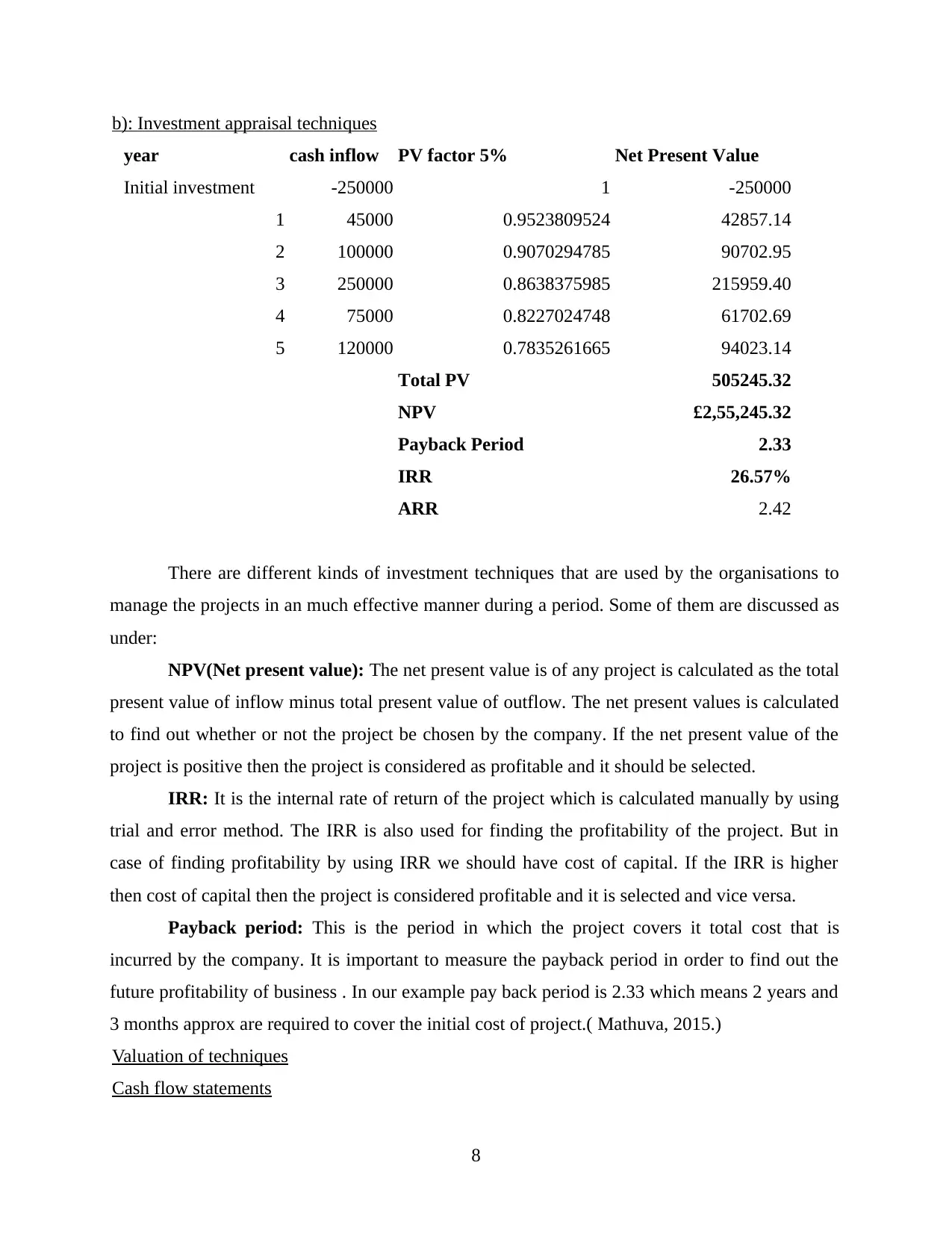
b): Investment appraisal techniques
year cash inflow PV factor 5% Net Present Value
Initial investment -250000 1 -250000
1 45000 0.9523809524 42857.14
2 100000 0.9070294785 90702.95
3 250000 0.8638375985 215959.40
4 75000 0.8227024748 61702.69
5 120000 0.7835261665 94023.14
Total PV 505245.32
NPV £2,55,245.32
Payback Period 2.33
IRR 26.57%
ARR 2.42
There are different kinds of investment techniques that are used by the organisations to
manage the projects in an much effective manner during a period. Some of them are discussed as
under:
NPV(Net present value): The net present value is of any project is calculated as the total
present value of inflow minus total present value of outflow. The net present values is calculated
to find out whether or not the project be chosen by the company. If the net present value of the
project is positive then the project is considered as profitable and it should be selected.
IRR: It is the internal rate of return of the project which is calculated manually by using
trial and error method. The IRR is also used for finding the profitability of the project. But in
case of finding profitability by using IRR we should have cost of capital. If the IRR is higher
then cost of capital then the project is considered profitable and it is selected and vice versa.
Payback period: This is the period in which the project covers it total cost that is
incurred by the company. It is important to measure the payback period in order to find out the
future profitability of business . In our example pay back period is 2.33 which means 2 years and
3 months approx are required to cover the initial cost of project.( Mathuva, 2015.)
Valuation of techniques
Cash flow statements
8
year cash inflow PV factor 5% Net Present Value
Initial investment -250000 1 -250000
1 45000 0.9523809524 42857.14
2 100000 0.9070294785 90702.95
3 250000 0.8638375985 215959.40
4 75000 0.8227024748 61702.69
5 120000 0.7835261665 94023.14
Total PV 505245.32
NPV £2,55,245.32
Payback Period 2.33
IRR 26.57%
ARR 2.42
There are different kinds of investment techniques that are used by the organisations to
manage the projects in an much effective manner during a period. Some of them are discussed as
under:
NPV(Net present value): The net present value is of any project is calculated as the total
present value of inflow minus total present value of outflow. The net present values is calculated
to find out whether or not the project be chosen by the company. If the net present value of the
project is positive then the project is considered as profitable and it should be selected.
IRR: It is the internal rate of return of the project which is calculated manually by using
trial and error method. The IRR is also used for finding the profitability of the project. But in
case of finding profitability by using IRR we should have cost of capital. If the IRR is higher
then cost of capital then the project is considered profitable and it is selected and vice versa.
Payback period: This is the period in which the project covers it total cost that is
incurred by the company. It is important to measure the payback period in order to find out the
future profitability of business . In our example pay back period is 2.33 which means 2 years and
3 months approx are required to cover the initial cost of project.( Mathuva, 2015.)
Valuation of techniques
Cash flow statements
8
Paraphrase This Document
Need a fresh take? Get an instant paraphrase of this document with our AI Paraphraser
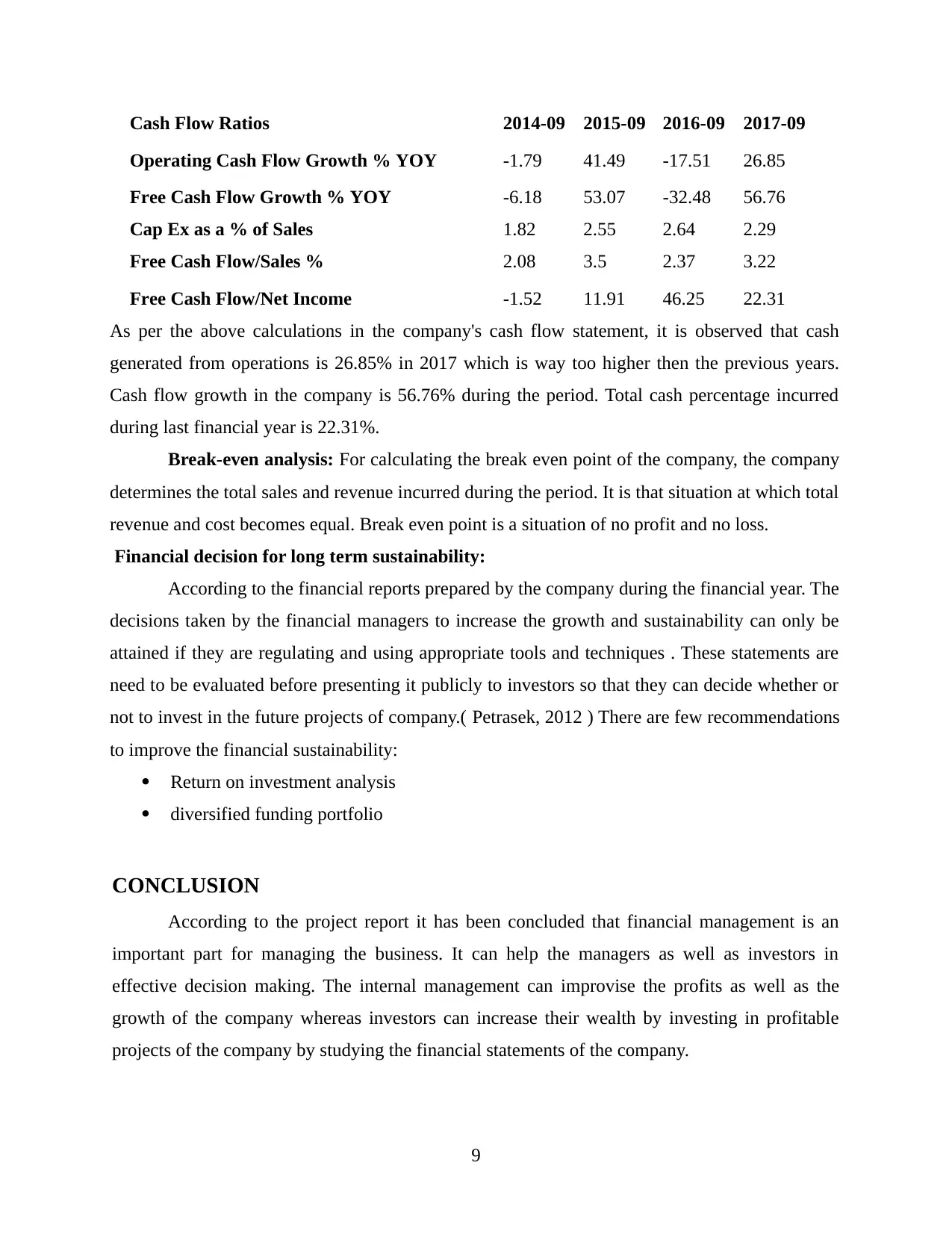
Cash Flow Ratios 2014-09 2015-09 2016-09 2017-09
Operating Cash Flow Growth % YOY -1.79 41.49 -17.51 26.85
Free Cash Flow Growth % YOY -6.18 53.07 -32.48 56.76
Cap Ex as a % of Sales 1.82 2.55 2.64 2.29
Free Cash Flow/Sales % 2.08 3.5 2.37 3.22
Free Cash Flow/Net Income -1.52 11.91 46.25 22.31
As per the above calculations in the company's cash flow statement, it is observed that cash
generated from operations is 26.85% in 2017 which is way too higher then the previous years.
Cash flow growth in the company is 56.76% during the period. Total cash percentage incurred
during last financial year is 22.31%.
Break-even analysis: For calculating the break even point of the company, the company
determines the total sales and revenue incurred during the period. It is that situation at which total
revenue and cost becomes equal. Break even point is a situation of no profit and no loss.
Financial decision for long term sustainability:
According to the financial reports prepared by the company during the financial year. The
decisions taken by the financial managers to increase the growth and sustainability can only be
attained if they are regulating and using appropriate tools and techniques . These statements are
need to be evaluated before presenting it publicly to investors so that they can decide whether or
not to invest in the future projects of company.( Petrasek, 2012 ) There are few recommendations
to improve the financial sustainability:
Return on investment analysis
diversified funding portfolio
CONCLUSION
According to the project report it has been concluded that financial management is an
important part for managing the business. It can help the managers as well as investors in
effective decision making. The internal management can improvise the profits as well as the
growth of the company whereas investors can increase their wealth by investing in profitable
projects of the company by studying the financial statements of the company.
9
Operating Cash Flow Growth % YOY -1.79 41.49 -17.51 26.85
Free Cash Flow Growth % YOY -6.18 53.07 -32.48 56.76
Cap Ex as a % of Sales 1.82 2.55 2.64 2.29
Free Cash Flow/Sales % 2.08 3.5 2.37 3.22
Free Cash Flow/Net Income -1.52 11.91 46.25 22.31
As per the above calculations in the company's cash flow statement, it is observed that cash
generated from operations is 26.85% in 2017 which is way too higher then the previous years.
Cash flow growth in the company is 56.76% during the period. Total cash percentage incurred
during last financial year is 22.31%.
Break-even analysis: For calculating the break even point of the company, the company
determines the total sales and revenue incurred during the period. It is that situation at which total
revenue and cost becomes equal. Break even point is a situation of no profit and no loss.
Financial decision for long term sustainability:
According to the financial reports prepared by the company during the financial year. The
decisions taken by the financial managers to increase the growth and sustainability can only be
attained if they are regulating and using appropriate tools and techniques . These statements are
need to be evaluated before presenting it publicly to investors so that they can decide whether or
not to invest in the future projects of company.( Petrasek, 2012 ) There are few recommendations
to improve the financial sustainability:
Return on investment analysis
diversified funding portfolio
CONCLUSION
According to the project report it has been concluded that financial management is an
important part for managing the business. It can help the managers as well as investors in
effective decision making. The internal management can improvise the profits as well as the
growth of the company whereas investors can increase their wealth by investing in profitable
projects of the company by studying the financial statements of the company.
9
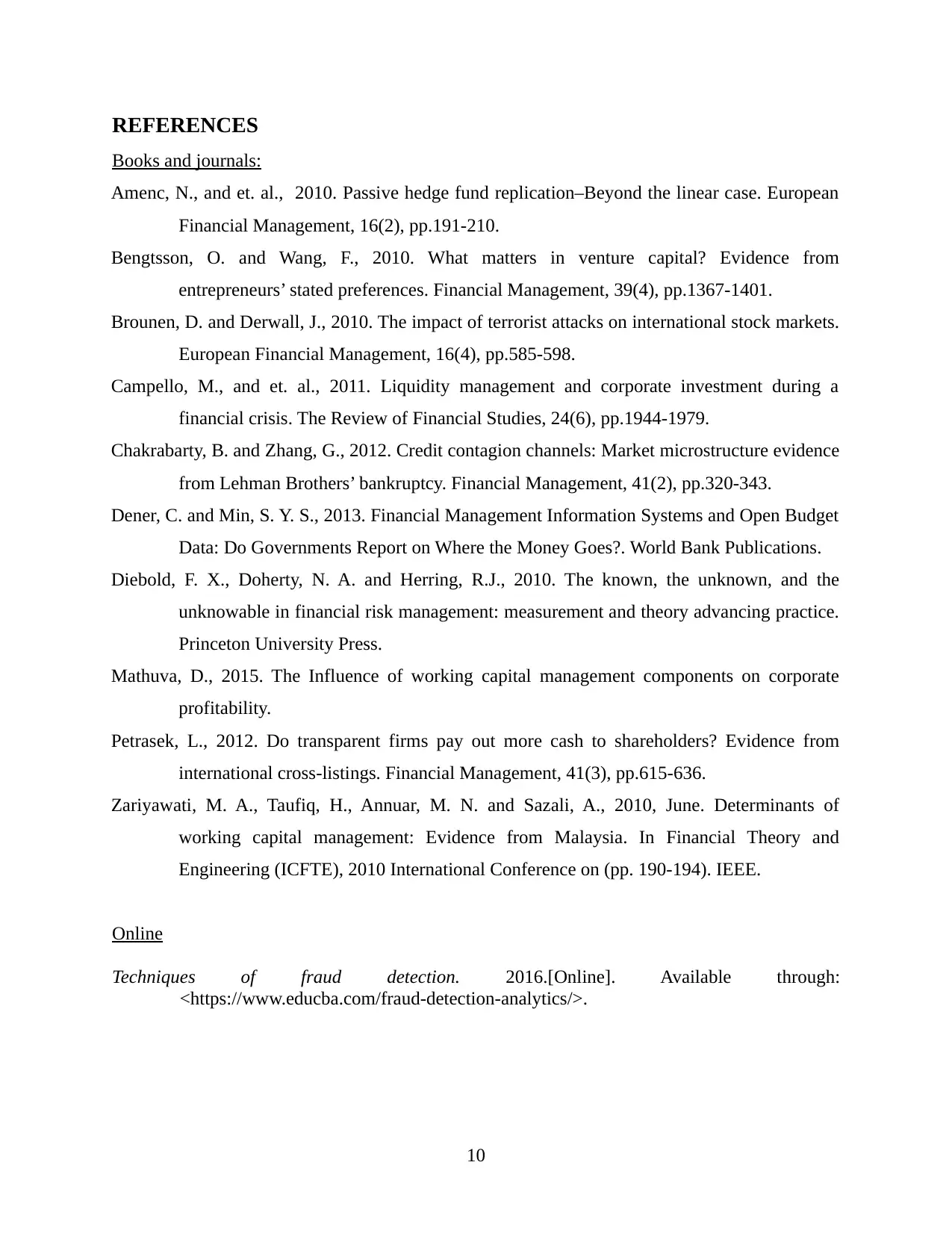
REFERENCES
Books and journals:
Amenc, N., and et. al., 2010. Passive hedge fund replication–Beyond the linear case. European
Financial Management, 16(2), pp.191-210.
Bengtsson, O. and Wang, F., 2010. What matters in venture capital? Evidence from
entrepreneurs’ stated preferences. Financial Management, 39(4), pp.1367-1401.
Brounen, D. and Derwall, J., 2010. The impact of terrorist attacks on international stock markets.
European Financial Management, 16(4), pp.585-598.
Campello, M., and et. al., 2011. Liquidity management and corporate investment during a
financial crisis. The Review of Financial Studies, 24(6), pp.1944-1979.
Chakrabarty, B. and Zhang, G., 2012. Credit contagion channels: Market microstructure evidence
from Lehman Brothers’ bankruptcy. Financial Management, 41(2), pp.320-343.
Dener, C. and Min, S. Y. S., 2013. Financial Management Information Systems and Open Budget
Data: Do Governments Report on Where the Money Goes?. World Bank Publications.
Diebold, F. X., Doherty, N. A. and Herring, R.J., 2010. The known, the unknown, and the
unknowable in financial risk management: measurement and theory advancing practice.
Princeton University Press.
Mathuva, D., 2015. The Influence of working capital management components on corporate
profitability.
Petrasek, L., 2012. Do transparent firms pay out more cash to shareholders? Evidence from
international cross‐listings. Financial Management, 41(3), pp.615-636.
Zariyawati, M. A., Taufiq, H., Annuar, M. N. and Sazali, A., 2010, June. Determinants of
working capital management: Evidence from Malaysia. In Financial Theory and
Engineering (ICFTE), 2010 International Conference on (pp. 190-194). IEEE.
Online
Techniques of fraud detection. 2016.[Online]. Available through:
<https://www.educba.com/fraud-detection-analytics/>.
10
Books and journals:
Amenc, N., and et. al., 2010. Passive hedge fund replication–Beyond the linear case. European
Financial Management, 16(2), pp.191-210.
Bengtsson, O. and Wang, F., 2010. What matters in venture capital? Evidence from
entrepreneurs’ stated preferences. Financial Management, 39(4), pp.1367-1401.
Brounen, D. and Derwall, J., 2010. The impact of terrorist attacks on international stock markets.
European Financial Management, 16(4), pp.585-598.
Campello, M., and et. al., 2011. Liquidity management and corporate investment during a
financial crisis. The Review of Financial Studies, 24(6), pp.1944-1979.
Chakrabarty, B. and Zhang, G., 2012. Credit contagion channels: Market microstructure evidence
from Lehman Brothers’ bankruptcy. Financial Management, 41(2), pp.320-343.
Dener, C. and Min, S. Y. S., 2013. Financial Management Information Systems and Open Budget
Data: Do Governments Report on Where the Money Goes?. World Bank Publications.
Diebold, F. X., Doherty, N. A. and Herring, R.J., 2010. The known, the unknown, and the
unknowable in financial risk management: measurement and theory advancing practice.
Princeton University Press.
Mathuva, D., 2015. The Influence of working capital management components on corporate
profitability.
Petrasek, L., 2012. Do transparent firms pay out more cash to shareholders? Evidence from
international cross‐listings. Financial Management, 41(3), pp.615-636.
Zariyawati, M. A., Taufiq, H., Annuar, M. N. and Sazali, A., 2010, June. Determinants of
working capital management: Evidence from Malaysia. In Financial Theory and
Engineering (ICFTE), 2010 International Conference on (pp. 190-194). IEEE.
Online
Techniques of fraud detection. 2016.[Online]. Available through:
<https://www.educba.com/fraud-detection-analytics/>.
10
⊘ This is a preview!⊘
Do you want full access?
Subscribe today to unlock all pages.

Trusted by 1+ million students worldwide
1 out of 13
Related Documents
Your All-in-One AI-Powered Toolkit for Academic Success.
+13062052269
info@desklib.com
Available 24*7 on WhatsApp / Email
![[object Object]](/_next/static/media/star-bottom.7253800d.svg)
Unlock your academic potential
Copyright © 2020–2025 A2Z Services. All Rights Reserved. Developed and managed by ZUCOL.



